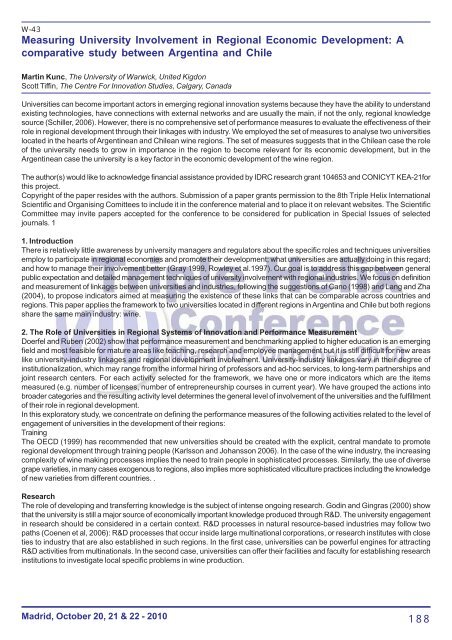TRIPLE HELIX noms.pmd
TRIPLE HELIX noms.pmd
TRIPLE HELIX noms.pmd
Create successful ePaper yourself
Turn your PDF publications into a flip-book with our unique Google optimized e-Paper software.
W-43Measuring University Involvement in Regional Economic Development: Acomparative study between Argentina and ChileMartin Kunc, The University of Warwick, United KigdonScott Tiffin, The Centre For Innovation Studies, Calgary, CanadaUniversities can become important actors in emerging regional innovation systems because they have the ability to understandexisting technologies, have connections with external networks and are usually the main, if not the only, regional knowledgesource (Schiller, 2006). However, there is no comprehensive set of performance measures to evaluate the effectiveness of theirrole in regional development through their linkages with industry. We employed the set of measures to analyse two universitieslocated in the hearts of Argentinean and Chilean wine regions. The set of measures suggests that in the Chilean case the roleof the university needs to grow in importance in the region to become relevant for its economic development, but in theArgentinean case the university is a key factor in the economic development of the wine region.The author(s) would like to acknowledge financial assistance provided by IDRC research grant 104653 and CONICYT KEA-21forthis project.Copyright of the paper resides with the authors. Submission of a paper grants permission to the 8th Triple Helix InternationalScientific and Organising Comittees to include it in the conference material and to place it on relevant websites. The ScientificCommittee may invite papers accepted for the conference to be considered for publication in Special Issues of selectedjournals. 11. IntroductionThere is relatively little awareness by university managers and regulators about the specific roles and techniques universitiesemploy to participate in regional economies and promote their development; what universities are actually doing in this regard;and how to manage their involvement better (Gray 1999, Rowley et al.1997). Our goal is to address this gap between generalpublic expectation and detailed management techniques of university involvement with regional industries. We focus on definitionand measurement of linkages between universities and industries, following the suggestions of Cano (1998) and Lang and Zha(2004), to propose indicators aimed at measuring the existence of these links that can be comparable across countries andregions. This paper applies the framework to two universities located in different regions in Argentina and Chile but both regionsshare the same main industry: wine.2. The Role of Universities in Regional Systems of Innovation and Performance MeasurementDoerfel and Ruben (2002) show that performance measurement and benchmarking applied to higher education is an emergingfield and most feasible for mature areas like teaching, research and employee management but it is still difficult for new areaslike university-industry linkages and regional development involvement. University-industry linkages vary in their degree ofinstitutionalization, which may range from the informal hiring of professors and ad-hoc services, to long-term partnerships andjoint research centers. For each activity selected for the framework, we have one or more indicators which are the itemsmeasured (e.g. number of licenses, number of entrepreneurship courses in current year). We have grouped the actions intobroader categories and the resulting activity level determines the general level of involvement of the universities and the fulfillmentof their role in regional development.In this exploratory study, we concentrate on defining the performance measures of the following activities related to the level ofengagement of universities in the development of their regions:TrainingThe OECD (1999) has recommended that new universities should be created with the explicit, central mandate to promoteregional development through training people (Karlsson and Johansson 2006). In the case of the wine industry, the increasingcomplexity of wine making processes implies the need to train people in sophisticated processes. Similarly, the use of diversegrape varieties, in many cases exogenous to regions, also implies more sophisticated viticulture practices including the knowledgeof new varieties from different countries. .ResearchThe role of developing and transferring knowledge is the subject of intense ongoing research. Godin and Gingras (2000) showthat the university is still a major source of economically important knowledge produced through R&D. The university engagementin research should be considered in a certain context. R&D processes in natural resource-based industries may follow twopaths (Coenen et al, 2006): R&D processes that occur inside large multinational corporations, or research institutes with closeties to industry that are also established in such regions. In the first case, universities can be powerful engines for attractingR&D activities from multinationals. In the second case, universities can offer their facilities and faculty for establishing researchinstitutions to investigate local specific problems in wine production.Madrid, October 20, 21 & 22 - 2010188










